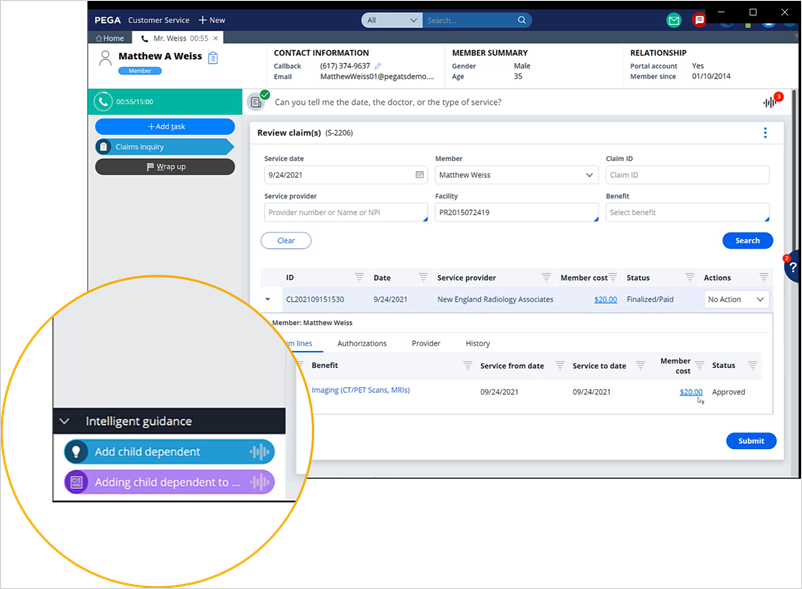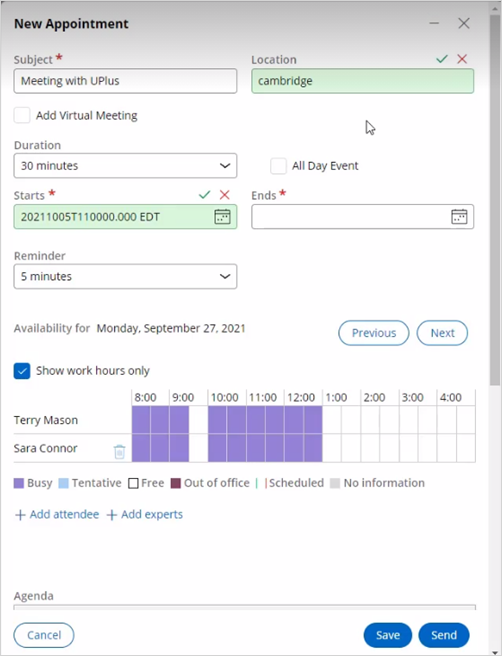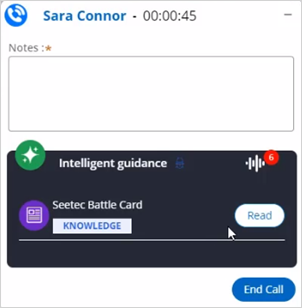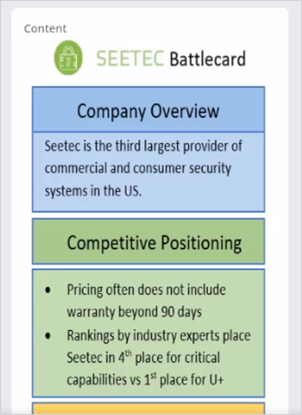
Voice AI features
VoiceAI features
During a live call with a customer, a representative must have quick access to relevant scripts, case types, forms, and knowledge articles. These artifacts represent the operating procedures and accumulated knowledge of your organization. Voice AI analyzes the context of the call and surfaces relevant information as a representative speaks with a customer.
This topic describes the main features of Voice AI.
Script adherence
A support or sales organization has scripts for common sales and service situations. Scripts often have required steps to meet HIPAA and fiduciary compliance. For example, a representative must verify a person's identity, or make required financial disclosures.
When a representative is on a call with a customer, Voice AI detects whether the representative follows the defined script. This can be set to require a verbatim match or allow for fuzzy matches.
The representative sees the script text with an exclamation icon:
After the representative says the script text, the icon indicates the match:
By checking script adherence, Voice AI can:
- Remind the representative to provide required statements or disclosures
- Ensure that cases are handled in a consistent manner
- Provides guidance for new representatives
Case suggestion
Representatives use preconfigured cases to help resolve customer issues. A case walks through a defined process and displays forms used to gather the appropriate information and process the customer request.
Based on the context of a live conversation, Voice AI recommends cases to be launched.
For example, a customer calls and asks about adding their new baby to their health plan. Voice AI detects the context and displays a suggested case in the Intelligent Guidance section of the Interaction Portal.
The representative clicks the suggested case to process the customer request.
As a sales or support organization processes cases, Voice AI learns to detect context from an adaptive model that changes with each new case.
In another example, a customer is talking with a representative about renewing their product subscription. The customer suggests a meeting, which triggers the New Appointment case.
By quickly identifying related case types, Voice AI lets you:
- Create a case with one click
- Get guidance on how to process the request
- Save time by not searching for the appropriate case type
Form autofill
As the representative processes a customer request, the case displays forms to gather customer information, such as a shipping address or account-related information. Voice AI can autofill form fields with information that the customer provides via the conversation.
Form autofill populates empty form fields; it does not overwrite existing customer information.
Voice AI detects entities, such as a name or date, spoken by the customer and populates the corresponding form fields automatically.
The representative sees the completed fields and can click the green check mark to approve each entry.
Using autofill, VoiceAI provides "hands-free" form field entry and reduces handling time.
Behind the scenes, Voice AI detects entities spoken by the customer and keeps track of them in the entity list. When a case is launched, Voice AI looks for form fields, such as Date of Birth, that have been configured to work with form autofill and checks the entity list for matching entries. A representative can view the entity list by clicking the red entity count icon.
Knowledge suggestion
During the conversation, a customer may ask for specific information about a policy, product, or case. Voice AI can quickly search an organization's knowledgebase and identify relevant articles. This feature requires that the customer is using Pega Knowledge.
For example, a customer tells the representative that they are looking at a proposal from a competitor. VoiceAI searches Pega Knowledge for information on the competitor and finds a "battle card."
The representative clicks the link to display the information and relays the main points to the customer.
In another example, a customer asks about adding a newborn to their health plan. The representative sees a suggested article in the Intelligent Guidance section in the Interaction Portal.
The representative clicks the suggested article to display it:
A representative can relay the information over the phone, or email the article to the customer.
By quickly finding related knowledge articles, Voice AI:
- Eliminates the need to manually search for knowledge
- Surfaces relevant contextual content that the representative may not know exists
- Lets the representative launch content in real-time and leverage it during a call
This Topic is available in the following Module:
If you are having problems with your training, please review the Pega Academy Support FAQs.
Want to help us improve this content?









